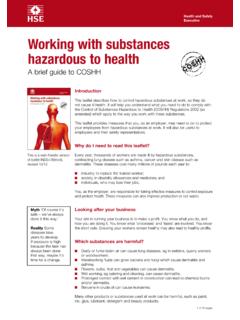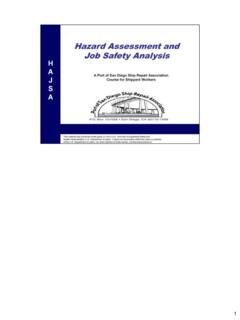Transcription of Process Safety Management for Small Businesses
1 OSHA 3908-03 2017 Process Safety Management for Small BusinessesOccupational Safety and Health Act of 1970 To assure safe and healthful working conditions for working men and women; by authorizing enforcement of the standards developed under the Act; by assisting and encouraging the States in their efforts to assure safe and healthful working conditions; by providing for research, information, education, and training in the field of occupational Safety and health. This guidance document is not a standard or regulation, and it creates no new legal obligations. It contains recommendations as well as descriptions of mandatory Safety and health standards. The recommendations are advisory in nature, informational in content, and are intended to assist employers in providing a safe and healthful workplace. The Occupational Safety and Health Act requires employers to comply with Safety and health standards and regulations promulgated by OSHA or by a state with an OSHA approved state plan.
2 In addition, the Act s General Duty Clause, Section 5(a)(1), requires employers to provide their employees with a workplace free from recognized hazards likely to cause death or serious physical contained in this publication is in the public domain and may be reproduced, fully or partially, without permission. Source credit is requested but not information will be made available to sensory impaired individuals upon request. Voice phone: (202) 693 1999; teletypewriter (TTY) number: 1 877 889 5627. Process Safety Management for Small Department of LaborOccupational Safety and Health AdministrationOSHA 3908 03 2017 ContentsPurpose ..1 Applicability ..3 Examples of Small Businesses with potential PSM covered processes ..5 Process Safety Information ..6 Process Hazard Analysis ..10 PHA Development Team ..12 training ..13 Mechanical Integrity.
3 14 Compliance Audit ..17 APPENDIX A: Frequently Asked Questions ..19 APPENDIX B: Examples of PHA Methodology ..25 Workers Rights ..28 OSHA Assistance, Services and Programs ..28 Establishing a Safety and Health Program ..28 Compliance Assistance Specialists ..28 Free On site Safety and Health Consultation Services for Small Business..28 Cooperative Programs ..29 Occupational Safety and Health training Courses ..29 OSHA Educational Materials ..30 OSHA Regional Offices ..31 How to Contact OSHA ..33 Process Safety Management FOR Small BUSINESSES1 PurposeThis guidance document does not cover the entire Process Safety Management standard (PSM), but only focuses on aspects of the standard that may be particularly helpful for Small Businesses . For a full compliance guide to PSM, please refer to OSHA s Process Safety Management Guide (OSHA 3132)1 or the full text of the standard at Although all elements of the PSM standard apply to a PSM covered Small business, the following elements of the standard are most relevant to hazards associated with Small Businesses .
4 Process Safety Information (PSI) Process Hazards Analysis (PHA) training Mechanical Integrity (MI) Compliance AuditsPSM is critically important to Small Businesses with highly hazardous chemicals. Implementing the required Safety programs help prevent fires, explosions, large chemical spills, toxic gas releases, runaway chemical reactions, and other major incidents. Compliance with the PSM standard will help ensure that employees, contractors, facility visitors, and emergency responders are safe from these hazards. Compliance will also benefit employers by minimizing damage to facility equipment and neighboring structures in the event of an HHC release. Managing HHCs is required by OSHA standards and a good business Catastrophic HHC release events continue to occur among smaller companies. One study estimates that employers with 1 25 employees are 47 times more likely to have a release and 17 times more likely to suffer an injury, per employee, than facilities with 1500 or more 1.
5 See The Business Case for Process Safety , downloadable from case4. Process Safety Issues For Small Businesses M. Sam Mannan, Harry H. West, Nir Keren and T. Michael O Connor, Mary Kay O Connor Process Safety Center, 2004. IChemEOCCUPATIONAL Safety AND HEALTH ADMINISTRATION2In addition to presenting risk to workers these companies are often located in populated areas, and can pose a risk to the surrounding population and Small companies have the potential to realize cost efficiencies and savings through improved Safety practices, such as adopting more effective work practices, inventory controls, storage practices, and better handling, use and disposal procedures, and instituting targeted PSM training to improve and ensure employee competence. Where possible and practical, finding alternative materials will help reduce hazards and associated risks.
6 The approaches in this guidance document can help Small Businesses meet PSM requirements without creating unnecessary or additional resource burdens, and will give both employees and employers a better understanding of the standard. Many industry organizations have materials that may contain guidance for specific industries and processes. Small Businesses may find this guidance helpful in developing a PSM program. Such industries include, but are not limited to: Refrigeration International Institute of Ammonia Refrigeration (IIAR) Compressed Gasses Compressed Gas Association (CGA) Petrochemical and Chemical Manufacturers American Petroleum Institute (API) Chemical Manufacturers Society of Chemical Manufacturers and Affiliates (SOCMA) Chemical Distribution/Supply chain National Association of Chemical Distributors (NACD) Agricultural Wholesalers Agricultural Retailers Association (ARA) & The Fertilizer Institute (TFI) Chlorine users (water/wastewater treatment and others) The Chlorine Institute Explosives Manufacturing Institute of Makers of Explosives (IME) Pyrotechnics American Pyrotechnics AssociationPROCESS Safety Management FOR Small BUSINESSES3 Composite Manufacturers American Composites Manufacturers Association (ACMA)
7 Petrochemical Manufacturing American Fuel and Petrochemical Manufacturers (AFPM) Dairy Manufacturing The International Dairy Foods Association (IDFA) Paint Coating American Coatings Association (ACA)ApplicabilityThe Process Safety Management standard covers processes which involve threshold quantity (TQ) of chemicals listed in Appendix A of the PSM The PSM standard also applies to processes containing 10,000 pounds ( kg) or more of either a Category 1 flammable gas (as defined in 29 CFR (c)) or a flammable liquid with a flashpoint below 100 F ( C) on site in one location, and to the manufacture of explosives or pyrotechnics in any quantity, except for: Retail facilities Hydrocarbon fuels used solely for workplace consumption as a fuel ( , propane used for comfort heating, gasoline for vehicle refueling), if such fuels are not a part of a Process containing another highly hazardous chemical (HHC) covered by the PSM standard Flammable liquids with a flashpoint below 100 F ( C) stored in atmospheric tanks or transferred which are kept below their normal boiling point without benefit of chilling or refrigeration.
8 (Note: Atmospheric tanks are storage tanks designed to operate at pressures from atmospheric through psig) Oil or gas well drilling or servicing operations Normally unoccupied remote facilities65. Calculation of TQ for mixtures is explained in an OSHA Letter of Interpretation at Letter of Interpretation: Safety AND HEALTH ADMINISTRATION4 Although OSHA believes PSM will have a positive effect on the Safety and health of employees and will offer potential benefits to employers such as increased productivity, smaller Businesses with limited resources might consider alternative approaches to decreasing HHC associated risks at their workplaces. One possible approach is reducing their HHC inventories to below the PSM TQ by improving inventory control and accepting smaller deliveries. Inventory reduction may help reduce the consequences of a catastrophic incident.
9 When reduced inventory is not feasible, the employer might consider dispersing inventory among several on site locations such that a release/incident in one location will not cause a release in another. However, reducing inventories below the PSM TQs does not relieve employers of their responsibility under the OSH Act to provide safe and healthful working conditions for their employees. Simply reducing inventories has no effect on the properties of the HHCs, which, depending on their use in a Process , may still present hazards to workers. OSHA encourages employers handling HHCs who are not subject to the PSM standard to implement Safety and health Management systems to protect their employees. Small Businesses may contact OSHA s free On site Consultation Program for help with identifying and mitigating workplace hazards. OSHA s On site Consultation Program offers free and confidential occupational Safety and health services to Small and medium sized Businesses in all states and several territories, with priority given to high hazard worksites.
10 To locate the OSHA On site Consultation Program nearest you, call 1 800 321 6742 (OSHA) or visit Process Safety Management FOR Small BUSINESSES5 Examples of Small Businesses with potential PSM-covered processesThe following list contains examples of Businesses potentially affected by the PSM standard (NAICS codes are included for clarity, but they are not used to determine the PSM standard s applicability): Asphalt Paving/Roofing Materials (NAICS 32412) Chemical and Allied Products (NAICS 4246) Chemical Products Misc (NAICS 42469) Drugs (NAICS 4242) Fabricated Metal (NAICS 332) Fabricated Rubber Products, (NAICS 32521) Food and Kindred Products (NAICS 31199) Industrial Organic Chemicals (NAICS 32519) Inorganic Chemical Manufacturing (NAICS 32518) Lumber, Wood Products (NAICS 321) Natural Gas Liquids (NAICS 2212) Paints, Varnishes, Enamels (NAICS 3255) Paper and Allied Products (NAICS 32229) Plastics Products Miscellaneous (NAICS 3261) Plastics, Rubber, Cellulosics (NAICS 325211) Petroleum & Coal Products Misc (NAICS 32419) Petroleum Refining (NAICS 32411) Primary Metals Industries (NAICS 331) Stone, Glass & Concrete (NAICS 21232, 3272, 3273) Textile Mill Products (NAICS 3131) Wholesale Trade (NAICS 42)















